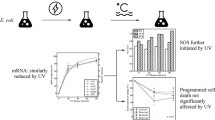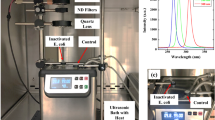Abstract
Bacteria in nature often suffer sudden stresses, such as ultraviolet (UV) irradiation, nutrient deprivation, and chemotoxins that would cause DNA damage and DNA replication failure, which in turn trigger SOS response. According to the strength and duration of the stress, the SOS system not only repairs DNA damage but also induces mutagenesis, so as to adapt to the changing environment. The key proteins in charge of mutagenesis are UmuD and UmuD’. In this paper, we quantitatively measure the growth rate and cellular levels of proteins UmuD and UmuD’ in Escherichia coli after various fluences of UV irradiation. To compare with the experimental observations, an ordinary differential equation model is built to describe the SOS response. Considering the fact that the DNA lesions affect cellular protein production and replication origination, the simulation results fit well with the experimental data. Our results show how the fluence of UV irradiation determines the dynamics of the inducing signal and the mutation frequency of the cell.




Similar content being viewed by others
References
Beuning PJ, Simon SM, Godoy VG et al (2006) Characterization of Escherichia coli translesion synthesis polymerases and their accessory factors. DNA Repair 408:318–340
Courcelle CT, Belle JJ, Courcelle J (2005) Nucleotide excision repair or polymerase V-mediated lesion bypass can act to restore UV-arrested replication forks in Escherichia coli. J Bacteriol 187:6953–6961
Courcelle J, Crowley DJ, Hanawalt PC (1999) Recovery of DNA replication in UV-irradiated Escherichia coli requires both excision repair and recF protein function. J Bacteriol 181:916–922
Courcelle J, Khodursky A, Peter B et al (2001) Comparative gene expression profiles following UV exposure in wild-type and SOS-deficient Escherichia coli. Genetics 158:41–64
Cox MM (2007) Regulation of bacterial RecA protein function. Crit Rev Biochem Mol 42:41–63
Crowley DJ, Hanawalt PC (1998) Induction of the SOS response increases the efficiency of global nucleotide excision repair of cyclobutane pyrimidine dimers, but not 6–4 photoproducts, in UV-irradiated Escherichia coli. J Bacteriol 180:3345–3352
Friedberg EC, Walker GC, Siede W et al (2005) DNA repair and mutagenesis, 2nd edn. ASM Press, Washington, DC, pp 463–464
Frank EG, Ennis DG, Gonzalez M et al (1996) Regulation of SOS mutagenesis by proteolysis. Proc Natl Acad Sci USA 93:10291–10296
Frank EG, Gonzalez M, Ennis DG et al (1996) In vivo stability of the Umu mutagenesis proteins: a major role for RecA. J Bacteriol 178:3550–3556
Friedman N, Vardi S, Ronen M et al (2005) Precise temporal modulation in the response of the SOS DNA repair network in individual bacteria. PLoS Biol 3:e238
Fujii S, Isogawa A, Fuchs RP (2006) RecFOR proteins are essential for Pol V-mediated translesion synthesis and mutagenesis. EMBO J 25:5754–5763
Galhardo RS, Hastings PJ, Rosenberg SM (2007) Mutation as a stress response and the regulation of evolvability. Crit Rev Biochem Mol 42:399–435
Gonzalez M, Woodgate R (2002) The “tale” of UmuD and its role in SOS mutagenesis. Bioessays 24:141–148
Sambrook J, EFF, T. Maniatis (1989) Molecular cloning: a laboratory manual, 2nd edn. Cold Spring Harbor Laboratory Press, Cold Spring Harbor, NY
Lusetti SL, Drees JC, Stohl EA et al (2004) The DinI and RecX proteins are competing modulators of RecA function. J Biol Chem 279:55073–55079
Michel B, Grompone G, Flores MJ et al (2004) Multiple pathways process stalled replication forks. Proc Natl Acad Sci USA 101:12783–12788
Neher SB, Sauer RT, Baker TA (2003) Distinct peptide signals in the UmuD and UmuD’ subunits of UmuD/D’ mediate tethering and substrate processing by the ClpXP protease. Proc Natl Acad Sci USA 100:13219–13224
Ni M, Wang SY, Li JK et al (2007) Simulating the temporal modulation of inducible DNA damage response in Escherichia coli. Biophys J 93:62–73
Opperman T, Murli S, Smith BT et al (1999) A model for a umuDC-dependent prokaryotic DNA damage checkpoint. Proc Natl Acad Sci USA 96:9218–9223
Renzette N, Gumlaw N, Sandler SJ (2007) DinI and RecX modulate RecA-DNA structures in Escherichia coli K–12. Mol Microbiol 63:103–115
Rudolph CJ, Upton AL, Lloyd RG (2007) Replication fork stalling and cell cycle arrest in UV-irradiated Escherichia coli. Genes Dev 21:668–681
Sassanfar M, Roberts JW (1990) Nature of the SOS-inducing signal in Escherichia coli the involvement of DNA replication. J Mol Biol 212:79–96
Schlacher K, Goodman MF (2007) Timeline—lessons from 50 years of SOS DNA-damage-induced mutagenesis. Nat Rev Mol Cell Biol 8:587–594
Tippin B, Pham P, Goodman MF (2004) Error-prone replication for better or worse. Trends Microbiol 12:288–295
Voloshin ON, Ramirez BE, Bax A et al (2001) A model for the abrogation of the SOS response by an SOS protein: a negatively charged helix in DinI mimics DNA in its interaction with RecA. Genes Dev 15:415–427
Author information
Authors and Affiliations
Corresponding author
Electronic Supplematntary Material
Rights and permissions
About this article
Cite this article
Ni, M., Yang, L., Liu, XL. et al. Fluence-Response Dynamics of the UV-Induced SOS Response in Escherichia coli . Curr Microbiol 57, 521–526 (2008). https://doi.org/10.1007/s00284-008-9235-4
Received:
Revised:
Accepted:
Published:
Issue Date:
DOI: https://doi.org/10.1007/s00284-008-9235-4




